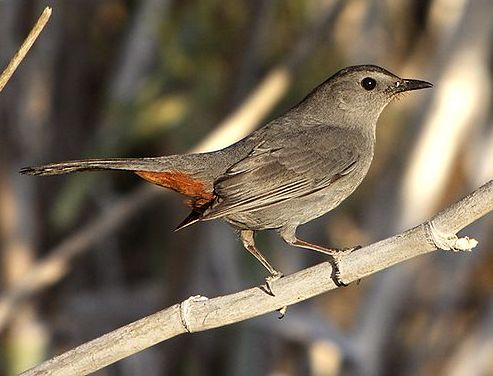
This week gray catbirds (Dumetella carolinensis) came back to Pittsburgh from their winter homes in Central America.
I saw my first one in Schenley Park on Tuesday (April 26) and now I hear them every day, singing from the coverts in my neighborhood. Here’s what they sound like:
“Grey Catbird (Dumetella carolinensis)” from xeno-canto by Antonio Xeira. Genre: Mimidae.
“Covert” means “thicket” but it’s also an ornithological term for feathers that cover the base of the main flight or tail feathers.
Gray catbirds have rust-colored undertail coverts. Read about them in this 2010 bird anatomy lesson: Undertail Coverts.
(photo by Alan Vernon in Wikimedia Commons. Click on the image to see the original)
We are blessed with a plethora of “mocking” birds in the woods around us. If we hear what sounds like 8 or 9 different birds singing from the same tree (sometimes with a cell phone ring or truck backup beeper thrown in) we know it’s the northern mockingbird. If it sounds like a good imitation of 5 or 6 birds, it’s the brown thrasher. If it sounds like a brown thrasher in a hurry that’s been drinking, we know it’s a gray catbird (the ones near us, at least, have frantic songs of single calls of other birds all strung together one right after the other…with the “mew” thrown in every so often for good measure).
This morning as we listened to the birds before leaving for work, I was trying to decide if one of the local wood thrushes was nearby or if one of the mocking birds was singing (the wood thrush is one of their favorite songs). I decided it must have actually been a wood thrush, though, because the song didn’t change after a minute.
Looks like a pip, in archives cam time 6:12
Baby is hatched 6:53 Pitt= Cath 6: 12 is cam time
I saw two of these this morning in CT. Very pretty.